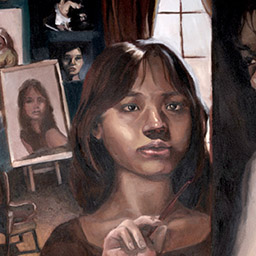
Ayisna Takhel
St George Girls High School
TRIPTYCH - REFLECTIONS OF THE STUDIO
Painting
My body of work explores my studio and artmaking processes. I focused on portraiture as a means of investigating the soul's, or the artist's, intimate relationship with the canvas, as well as referencing Renaissance artists such as Goya and Caravaggio whose influence and use of chiaroscuro greatly inspired me and my practice. Using mirrors and lighting to add greater depth and perspective, I invite the audience to place themselves in the studio, and to appreciate and explore the setting beyond what is seen on the canvas.
My artmaking practice has been influenced by the study and interpretation of the following artists: Francisco de Goya, Caravaggio.
Marker's Commentary
The long history of artists painting self-portraits in their studios, surrounded by the objects of their environment forms the basis of this painting triptych. Alongside the multiple self-portraits depicted, various images and reproductions by historical masters crowd the room, including Vermeer’s ‘The Milkmaid’ in the central panel and a classical bust in the right panel. In association with other foreground objects such as the bunch of green grapes, orange slice, voluptuous pink rose and carefully draped cloth hung over the mirror frame, they become symbols of the significance of portraiture and still life in painting’s history. The different viewing angles of the studio and each portrait’s reflection add complexity to the compositions and to the control of light. It is dramatic and theatrical and acts to intensify the subjectivity of the work. The painting is almost monochromatic in colour. Its rusty and deep burgundy hues, punctuated with hints of phthalo blue, pops of red and stark, warm white, allude to past times and direct the eye around foreground and background imagery. The inclusion of mirror frames acts as a structural device, enabling both harmony and tension to be achieved. Yet this mise-en-scene is not only concerned with ideas of the real. The structural aspects of the painting, with controlled lighting and directed close-up views, enable the development of character and setting that sets a warm and focused mood and creates thematic unity. The painter’s intense gazes and scrutiny of herself in the act of concentrated painting offers the audience voyeuristic insight into the creative process and a narrative of the artist’s acknowledgement and fascination with art history.


